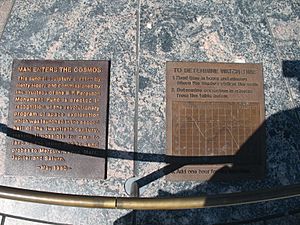Man Enters the Cosmos facts for kids
Quick facts for kids Man Enters the Cosmos |
|
|---|---|

The sculpture as seen with Lake Michigan in the background
|
|
| Artist | Henry Moore |
| Year | 1980 |
| Type | Bronze |
| Dimensions | 396 cm (156 in) |
| Location | Adler Planetarium (outdoor), Chicago, Illinois |
Man Enters the Cosmos is a large bronze sculpture created by Henry Moore. You can find it on the Lake Michigan lakefront, right outside the Adler Planetarium in downtown Chicago, Illinois.
The sculpture is actually a working sundial. It was made in 1980 and stands about 13 feet (3.96 meters) tall. This sundial is a later version of a similar one Moore made in the 1960s for a newspaper office in London.
Contents
What is Man Enters the Cosmos?
This sculpture is more than just a piece of art; it's also a tool to tell time using the sun! It's known as a "bowstring equatorial sundial."
Understanding the Sundial's Parts
The sculpture is made of two bronze half-circles. One half-circle sits inside the other, forming a right angle. A thin bronze rod stretches from one end of the outer half-circle to the other. This rod is called the gnomon. It's the part that casts a shadow. The sundial gets its "bowstring" name because this rod looks like the string of a bow.
The shadow from the rod falls onto the inner half-circle. This inner half-circle acts as the clock face, showing the time when the sun is shining.
How the Sundial Tells Time
The part of the gnomon that actually casts the shadow is called the style. As the year goes by, different parts of the rod act as the style.
- In summer, when the sun is highest, the style is near the top of the rod.
- In winter, when the sun is lowest, the style is near the bottom.
- During the spring and fall equinoxes, when day and night are almost equal, the style is exactly in the middle of the rod.
This type of sundial is called an "equatorial sundial" because its clock face is parallel to Earth's equator. Unlike simpler sundials, this design works all year round on the same surface.
Plaques on the Base
The sundial has two special plaques on its base:
- The plaque on the left explains that the sculpture was paid for by the B.F. Ferguson Monument fund. It was created to honor space exploration.
- The plaque on the right is a "time correction table." Sundials don't always show the exact time because of how the Earth tilts and moves around the sun. This table helps you adjust the time shown by the sundial to get the precise time. It also reminds you that it doesn't adjust for daylight saving time.
Moving the Sculpture
Between 1997 and 1999, the Adler Planetarium added a new section. Because of this, the roads around the planetarium were changed, and the sundial had to be moved.
First, the sculpture was carefully taken down and stored. Later, it was moved to its current spot on a walkway. Now, a U-turn in Solidarity Drive goes through where the sundial used to be.
Henry Moore's Sculptures in Chicago
Henry Moore, the artist, loved to see his sculptures outdoors. He believed they looked best in open spaces rather than inside buildings.
Chicago is home to four of Moore's public outdoor sculptures, all made of bronze:
- Man Enters the Cosmos (the sundial we're talking about) at the Adler Planetarium.
- Nuclear Energy at the University of Chicago. This sculpture marks the spot where the first self-sustaining nuclear reaction happened.
- Large Interior Form in the north garden of the Art Institute of Chicago.
- Reclining Figure, which is on loan to the University of Chicago and located in the Cochrane-Woods Art Center courtyard.
See also
 In Spanish: Man Enters the Cosmos para niños
In Spanish: Man Enters the Cosmos para niños


